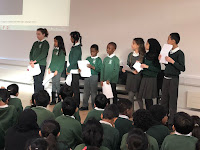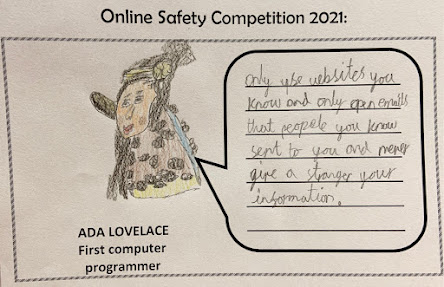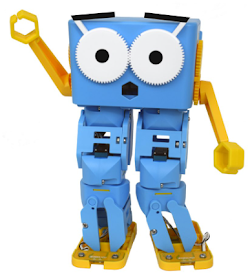#SID2018 - Poems, Posters and Penguins
We had a really successful week of activities to recognise Safer Internet Day 2018 on Tuesday, 6th February. In this blog, I will be sharing photos and resources from the week.
~ASSEMBLY~
I began on Monday morning with 2 assemblies for KS1 & KS2 that were lead by myself and our Digital Leaders. The Safer Internet Centre have tons of ideas and resources for the week.
Here is the link for the KS2 assembly PowerPoint.
Below are photos and resources for every year group...
~ RECEPTION ~
In Reception, I read them the story of Smartie the Penguin. This is a great e-safety story suitable for Reception or Year 1. It tells the story of Smartie who gets a new tablet but then encounters problems such as a Pop-Up Window, a website for older children and mean messages. The children learn to sing a special song: Before you tap or click, you need to stop and think, and tell someone!
Smartie (and the children) learn that you have to tell an adult if they have a problem.
The children then coloured a worksheet of Smartie, his parent and the song. For Year 1, I would get the children to write some advice that Smartie's parent could give and to write out the song themselves.
~ YEAR 1 ~
As mentioned, Smartie the Penguin works for Year 1 too, however this year I used Lee and Kim's Animal Magic Adventure. View the video here. This is a great story of Lee and Kim who are playing an online game with other people. They are on the verge of giving away their personal information when SID the Superhero stops them and transports them into the game where they get to see who they are really playing with...
After discussing the story with them, talking about personal information and what a stranger is, over 2 lessons, the children completed these activities.
Children can vote on the answer to the questions using these SID says YES & SID says NO cards.
There is also a Dot-to-Dot activity sheet of SID and Animal Masks that children can use to role-play the story.
~ YEAR 2 ~
I read with Year 2 the story of Digi-Duck. It tells the story of a duck who is about to send a funny picture of his friend to everyone he knows but before he does, a wise owl show him his future if she sent the picture. DigiDuck sees a future where he has no friends and no one wants to hang out with him. His friend in the photo was laughed at by everyone because of the photo and continued to get bullied. DigiDuck realises that it will be wrong to send the picture and reports it instead.
As follow up, children completed this worksheet where they sorted the story in order from the pictures and wrote a sentence about what was happening in each picture. This was to help them remember and learn the story and therefore the morals and messages from it.
We also spoke about creating, connecting and sharing respect and played a game where we all stood in a circle and each person took turns giving a compliment to someone else. Once they had given their compliment, they had to sit down. The next child, who had received the compliment, had to compliment someone else who was standing; so in the end everyone had given and received a compliment. We had all created a compliment, connect with each othernd shared respect.
~ YEAR 3 & 4 ~
After listening to the Safer Internet Day assembly, we began by talking about why the theme for this year is 'Create, Connect and Share Respect'. We discussed what people online can create, who can they connect with and what is meant by share respect.
I then gave them all a LearnPad and they connected to my Kahoot! Quiz. This is an amazing resource I have discovered recently which not only is a great new way to quiz children as it's interactive on a device rather than a whiteboard, the children win points, after every question it shows the top 5 children on the leader board. When the answer is revealed the tablet shows if they got the question right or wrong and tells them what ranking they are in the class.
At the end, I can use the quiz as a fantastic way of assessing their knowledge. I can download a spreadsheet which shows me the full leader board, what each child answered for each question and a very clear whole class view of questions that most children got wrong so I can identify gaps in their learning. I can also look at the bottom of the leaderboard to see the children who struggled the most with their e-safety knowledge.
I will be using Kahoot! as an assessment tool for other topics. It is free to sign up to - you just need a username and password.
I cannot link the quiz as I need to be signed in to launch it but it was based on the Safer Internet Day KS2 quiz which can be found here.
As a follow up activity, I tasked children with creating a Safer Internet Day poster that included elements from what they have learned in the assembly and quiz and they can include images of logos from websites or games they use when they go online.
~ YEAR 5 & 6 ~
At the start of the year, I tasked Year 5 with using the Storyboard That website to create a comic strip that portrays an e-safety scenario.
Box 1 should show someone being cyberbullied
Box 2 should show them reporting the bullying to a trusted adult
Box 3 should show the bullies being dealt with by the adults.
For Safer Internet Day, I worked with our Poet-In-Residence, Thomas 'GhettoGeek' Owoo to create SID Poetry Workshops for Year 5 & 6.
The objective was to give them input that included being sent 'fake' hurtful text messages so they can understand what it feels like to receive a message and feel empathetic towards victims. We also watched a video called DayDreaming made by children from another school. It tells the story of a girl being victimised by cyberbullies. We got children to discuss questions from the video.
This culminated with the children writing poems from a planning sheet that describes how it feels to send/receive a hurtful message? What should you do if you are the recipient? and What affect does cyber-bullying have on a victim? The children want people to read their poems, feel empathy, understand the affect cyber-bullying has and make positive choices when they are online.
Here are the resources we used in the workshop:
Here are four of the poems that some Year 6 children wrote. I typed them up using www.fakephonetext.com.
I was really please to see that lots of our work was re-tweeted by the Safer Internet Centre. In fact, the first tweet they re-tweeted on Safer Internet Day was my assembly. In the summer, we will be having an E-Safety Week where I will be blogging more resources so look out for that in June/July.




























Comments
Post a Comment